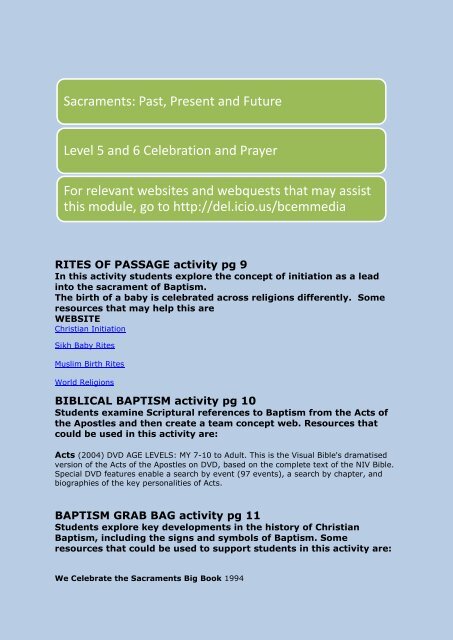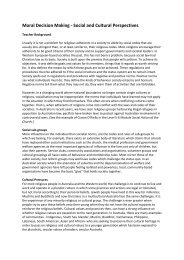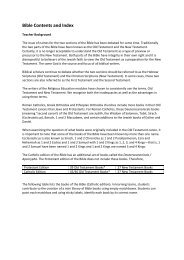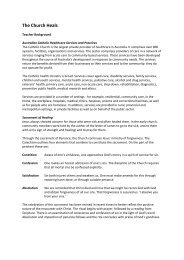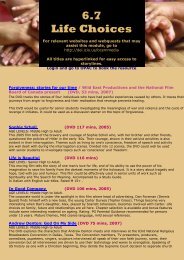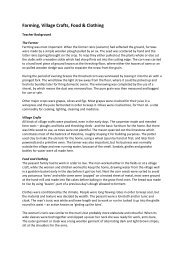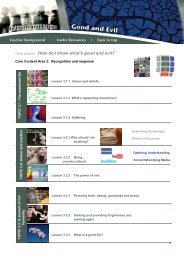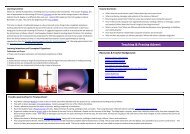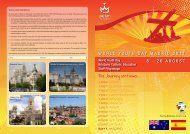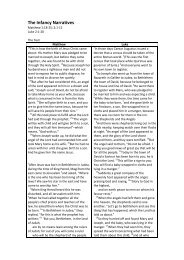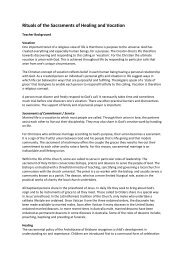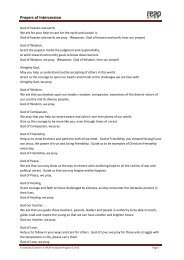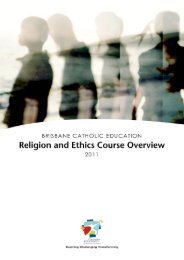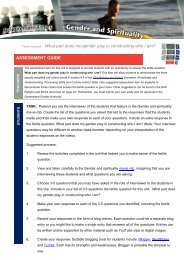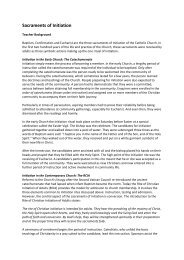Sacraments: Past, Present and Future Level 5 and 6 Celebration ...
Sacraments: Past, Present and Future Level 5 and 6 Celebration ...
Sacraments: Past, Present and Future Level 5 and 6 Celebration ...
Create successful ePaper yourself
Turn your PDF publications into a flip-book with our unique Google optimized e-Paper software.
<strong>Sacraments</strong>: <strong>Past</strong>, <strong>Present</strong> <strong>and</strong> <strong>Future</strong><br />
<strong>Level</strong> 5 <strong>and</strong> 6 <strong>Celebration</strong> <strong>and</strong> Prayer<br />
For relevant websites <strong>and</strong> webquests that may assist<br />
this module, go to http://del.icio.us/bcemmedia<br />
RITES OF PASSAGE activity pg 9<br />
In this activity students explore the concept of initiation as a lead<br />
into the sacrament of Baptism.<br />
The birth of a baby is celebrated across religions differently. Some<br />
resources that may help this are<br />
WEBSITE<br />
Christian Initiation<br />
Sikh Baby Rites<br />
Muslim Birth Rites<br />
World Religions<br />
BIBLICAL BAPTISM activity pg 10<br />
Students examine Scriptural references to Baptism from the Acts of<br />
the Apostles <strong>and</strong> then create a team concept web. Resources that<br />
could be used in this activity are:<br />
Acts (2004) DVD AGE LEVELS: MY 7-10 to Adult. This is the Visual Bible's dramatised<br />
version of the Acts of the Apostles on DVD, based on the complete text of the NIV Bible.<br />
Special DVD features enable a search by event (97 events), a search by chapter, <strong>and</strong><br />
biographies of the key personalities of Acts.<br />
BAPTISM GRAB BAG activity pg 11<br />
Students explore key developments in the history of Christian<br />
Baptism, including the signs <strong>and</strong> symbols of Baptism. Some<br />
resources that could be used to support students in this activity are:<br />
We Celebrate the <strong>Sacraments</strong> Big Book 1994
AGE LEVELS: Lower Primary to Junior High. This is an easel-style Big Book with images<br />
showing each of the <strong>Sacraments</strong>, their signs <strong>and</strong> symbols<br />
WEBSITE<br />
http://www.ourcatholicfaith.org/sacraments/baptism.html<br />
CATECHUMENATE CARTOONS activity pg 12<br />
In this module activity students design <strong>and</strong> create a double frame<br />
cartoon that highlights similarities <strong>and</strong> differences between the<br />
Catechumenate of the early Church <strong>and</strong> RCIA today. A resource that<br />
could be used in this activity is listed below:<br />
WEBSITE<br />
http://www.ourcatholicfaith.org/sacraments/baptism.html<br />
SEVEN SYMBOLS, ONE SACRAMENT activity pg 16<br />
Students design a concept map that depicts the seven symbols used<br />
in the contemporary celebration of the sacrament of confirmation.<br />
Resources that could be used to support students in this activity are:<br />
Students, initially discuss the idea of a rite of passage, where one<br />
celebrates with ceremony when one moves from one time in their life<br />
to another.<br />
We Celebrate the <strong>Sacraments</strong> Big Book BOOK 1994<br />
AGE LEVELS: Lower Primary to Junior High. This is an easel-style Big Book with images<br />
showing each of the <strong>Sacraments</strong>, their signs <strong>and</strong> symbols.<br />
The Sacrament of Confirmation: <strong>Past</strong> <strong>and</strong> present 2004 DVD AGE LEVELS: SS<br />
to Adult In the main program on the DVD (28 mins), Kathleen Chesto discusses the<br />
place of the Holy Spirit in our lives <strong>and</strong> describes the Spirit as 'the heart of everything<br />
that is'. In this context, she presents a history of the underst<strong>and</strong>ing <strong>and</strong> evolution of the<br />
Sacrament within the church <strong>and</strong> explores current debates around an appropriate<br />
theology of Confirmation <strong>and</strong> its role as a Sacrament of Initiation. This includes a<br />
discussion about the different ages when confirmation is celebrated around the world,<br />
with different accompanying theologies. The DVD includes some additional material, brief<br />
(one to two minute) stories about the Holy Spirit in their lives: - Charlotte's Advocate;<br />
Abigail's Search; John's Awareness; Betsy's Prayer; Ed's Faith; Confirmation Readiness;<br />
Ian's Insight; Mike's Recipe. Study Guide included.<br />
WEBSITE<br />
http://www.ourcatholicfaith.org/sacraments/confirm<br />
FOUR MOVEMENTS OF THE EUCHARIST activity pg 18<br />
In this module activity students explore the concept of meals <strong>and</strong><br />
draw parallels between meal stories in scriptural texts <strong>and</strong> the four<br />
movements of the Eucharist. Some resources that could be used to<br />
introduce the concepts to students are listed below:
Remember & Recognize - Underst<strong>and</strong>ing Catholic Eucharist<br />
DVD 25 mins 2005<br />
AGE LEVELS: Junior High to Adult. Eucharist is introduced here as both initiation into the<br />
Christian Community <strong>and</strong> the family meal. The key aspects of the Catholic Eucharist are<br />
presented: Last Supper - Remembrance; Word of God - Proclamation; Community -<br />
H<strong>and</strong>ed Down; Sacrifice - In Jesus' Love; Bread of Life - Nourishment; Real Presence -<br />
Personal <strong>and</strong> <strong>Past</strong>oral; Christ Among Us - Recognition. Visuals, music <strong>and</strong> audio from a<br />
variety of Eucharistic celebrations complement the commentary on each of the sections.<br />
This would be a useful resource for reflection on the meaning of Eucharist, for RCIA, <strong>and</strong><br />
for adult faith education. The DVD includes scene selection.<br />
Eucharist: The Source <strong>and</strong> the Summit DVD 27 mins 2005<br />
AGE LEVELS: Junior High to Adult. A program in three parts on the Eucharist: 1: We<br />
Participate: Fr Brendan Moss takes viewers through significant features of a Catholic<br />
Church <strong>and</strong> then of the celebration of the Eucharist. Words such as "anamnesis" <strong>and</strong><br />
"transubstantiation" are explained, as Eucharist is described as thanksgiving,<br />
remembering, sacrifice <strong>and</strong> meal. 2. We Pray: Sr Cathy Doherty explains the practice of<br />
Eucharistic Adoration <strong>and</strong> Benediction. 3: We Practise: Matuschka Lindo speaks about<br />
the way we live Eucharist in our daily lives. The detailed explanations would make this a<br />
useful resource for RCIA. With notes.<br />
Mass for Older Children DVD 15 mins 1998<br />
AGE LEVELS: Upper Primary to Junior High. Gaynell Cronin leads viewers through the<br />
stages of the Mass exploring the significance of each part <strong>and</strong> explaining some of the<br />
terminology used. The background of the Mass as a 'remembering <strong>and</strong> response' to the<br />
words <strong>and</strong> actions of Jesus is explained <strong>and</strong> the Eucharistic celebration is placed within<br />
the context of the daily lives of all who participate. With Notes<br />
WEBSITES<br />
http://www.catholicaustralia.com.au/page.php?pg=mi<br />
http://www.ourcatholicfaith.org/sacraments/euchari<br />
HISTORY OF THE EUCHARIST activity pg 19<br />
In small learning teams develop a wall display that illustrates key<br />
moments in the history of the Eucharist. Resources that could be<br />
used in this activity include:<br />
The Sacrament of Eucharist : past <strong>and</strong> present (2007) DVD AGE LEVELS: MY<br />
7-10 to Adult. Kathleen Chesto gives a general introduction to sacraments before<br />
exploring an underst<strong>and</strong>ing of Eucharist. She gives a clear presentation of how Eucharist<br />
developed from its beginning through to today. The part played by heresy <strong>and</strong> church<br />
councils, political influences, the impact of the destruction of the Jewish Temple, all are<br />
explained simply. The accompanying notes provide a guide to using the video with adult<br />
groups, RCIA <strong>and</strong> parents of children receiving First Eucharist.<br />
WEBSITE<br />
http://www.ourcatholicfaith.org/sacraments/euchari<br />
HEALING activity pg 25 Students investigate how the<br />
Sacrament of Anointing of the Sick is celebrated. They also explore<br />
the historical development of the Sacrament. Resources that could be<br />
used in this activity are listed below:
We Celebrate the <strong>Sacraments</strong> Big Book BOOK 1994<br />
AGE LEVELS: Lower Primary to Junior High. This is an easel-style Big Book with images<br />
showing each of the <strong>Sacraments</strong>, their signs <strong>and</strong> symbols.<br />
The sacrament of Anointing of the Sick : past <strong>and</strong> present (2005) DVD AGE<br />
LEVELS: MY 7-10 to Adult Written <strong>and</strong> presented by Kathleen Chesto, the DVD<br />
introduces the meaning of sacrament <strong>and</strong> then goes on to explain the development of<br />
this sacrament throughout history - from a sacrament of healing to one given in<br />
preparation for death. This development is explained <strong>and</strong> Kathleen explains that post<br />
Vatican 11 the sacrament has returned to its original status as one of healing <strong>and</strong><br />
support in sickness.<br />
WEBSITE<br />
http://www.ourcatholicfaith.org/sacraments/anointingthesick.html<br />
RECONCILIATION activity pg 28<br />
In small learning teams students investigate a time period in the<br />
development of the Sacrament of Reconciliation. Resources that<br />
could provide background information for teachers <strong>and</strong> students<br />
include:<br />
The Sacrament of Reconciliation : past <strong>and</strong> present (2007) DVD AGE LEVELS:<br />
MH-AD Here is a clear, simple, yet detailed overview of the history of the Sacrament of<br />
Reconciliation. It begins with the Hebrew concept of sin, then looks at Jesus' teachings,<br />
<strong>and</strong> Penance in the early Church, followed by an examination of the changes from 200AD<br />
to the present. Combined with Kathleen Chesto's explanation of the celebration of the<br />
rites today, this presentation provides a valuable resource for parents who are preparing<br />
their children for this Sacrament. Herself a parent, Dr Chesto identifies with the common<br />
experiences <strong>and</strong> feelings about Reconciliation, <strong>and</strong> her empathetic approach invites<br />
viewers to a renewed underst<strong>and</strong>ing of the Sacrament. The accompanying notes include<br />
discussion questions <strong>and</strong> a brief outline of the historical details covered.<br />
WEBSITE<br />
http://www.ourcatholicfaith.org/sacraments/penance.html<br />
CALLED FROM THE COMMUNITY activity pg 32<br />
Students explore in this activity the daily life of a priest <strong>and</strong> his role<br />
in the community. Some resources that could be used to illustrate<br />
the role of the priest are:<br />
Priesthood: men with a mission DVD 2008 - The DVD features priests from<br />
the Brisbane Archdiocese.<br />
The sacrament of Holy Orders : past <strong>and</strong> present (2005) DVD AGE LEVELS:<br />
MS to Adult The program, hosted by Kathleen Chesto explains how the original meaning<br />
of priesthood has changed over time. Originally a priest was one who, because of his<br />
gifts, was chosen by their community. This changed over time <strong>and</strong> the priest became<br />
separate from the community <strong>and</strong> received his gifts at his ordination. She explains that<br />
the idea of a priestly people with gifts also changed over time. Vatican 11 has tried to
ectify these mistaken interpretations <strong>and</strong> revert back to the initial idea of the laity as a<br />
priestly people <strong>and</strong> the priest as one who serves them.


